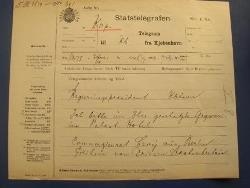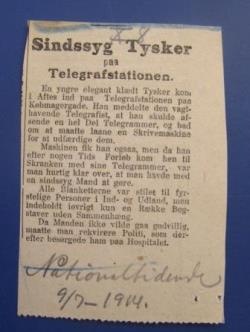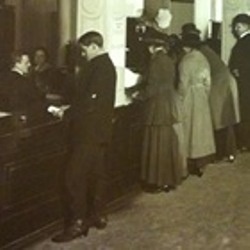Troubling telegrams in a troubled time
26. Jun. 2014

The mysterious telegram to the Danish Prime Minister, 1914.
On 8 July 1914, around 7:30 p.m., a number of telegram drafts scribbled in German were delivered at the Main Telegraph Station in Copenhagen. The sender was a young “German gentleman” with decent taste in clothes and convincing manners. Unfortunately, his handwriting did not hold the same standard. As a matter of fact, the text in the drafts was so difficult to read that the telegraph-assistant gave up on interpreting it.
The elegant customer, who presented himself as “Kommerz-Rath Levy aus Berlin”, demanded to borrow a typewriter, as he had “an exceptionally large amount of telegrams” that had to be dispatched. Here the story takes a rather bizarre turn, as “Mr Levy” began to draw up messages in a steady flow; messages that the staff were expected to forward in the form of telegrams.
The first specimen was addressed to the Danish Prime Minister, Carl Theodor Zahle, who, since the summer of 1913, had been head of the social-liberal government of the country. The message was concise, in classic telegraphic style, and it runs in translation: “I will stay at Palads Hotel in your esteemed company, Trade Counsellor Levy from Berlin, Baron of Driesen, State Secretary.”
However, the text was marred with spelling errors; so many in fact that the staff “began to doubt the man’s mental condition” – according to the internal report. Thus, the clerks contacted the Senior Telegrapher, who was in charge of the floor staff at the Copenhagen station. Yet he did not consider the content as conflicting with the Telegraph Instructions, which gave the station the right to withhold a telegram, if it was deemed a “danger to the security of the state” or “contrary to the laws of the country, to public order or to decency”.
Accordingly, the telegram was transmitted to the Danish PM, while the peculiar customer continued his typing. As a matter of fact, the said “Mr Levy” worked tirelessly on the machine for approximately two hours, and his behaviour became “more and more abnormal.” Finally, the case was handed over to the shift leader – the Senor Telegrapher had seemingly gone home for the day. And the shift leader concluded, after a closer inspection, that the drawn up messages “had nothing to do with telegrams, but was an insane assemblage of words.”
The odd German customer was now requested to stop his writing immediately. The typewriter was taken from him, and the PM was informed about “the circumstances under which the telegram had been conceived.” However, “Mr Levy” began to behave in an unpleasant, nearly threatening manner and the shift leader was forced to call for assistance from a nearby police station.

Danish news item about the peculiar incident, 1914. The heading runs: “Crazy German at the Telegraph Station”.
The behaviour of “Mr Levy” was undoubtedly eccentric, but there are also a number of external circumstances which further illuminate the growing anxiety among the staff at the Copenhagen station. The mysterious costumer turned up at a point in European history when politicians and diplomats worked at full stretch – and the telegraph cables hummed with secret notes and other diplomatic dispatches.
The reason was the assassination in Sarajevo, on 28 June, 1914, where the heir presumptive to the Austro-Hungarian throne, Archduke Franz Ferdinand, and his wife Sophie, were shot and killed in a political assassination with connections to the Serbian terrorist network “The Black Hand.” The incident was the prelude to a diplomatic crisis, which by the end of this fateful summer would cast the European Great Powers into the abyss of World War One, the apocalyptic “seminal catastrophe” of the 20th century.
According to the British-Australian historian Christopher Clark, the shockwaves triggered by the Sarajevo shootings can be compared to the effects of “Nine-eleven” in our own century. Clark, like many of his modern colleagues who have analysed the origins of World War One, emphasize the significance of the so-called “July Crisis” and the short-term decision-making in the weeks before the war. This viewpoint differs from older historiography, in which World War One was considered nearly inevitable, prompted by long-term historical developments.
The focus on diplomacy in recent historiography opens up interesting perspectives for the history of communications. For example, how did telegraphy affect the events and many fateful decisions? By the summer of 1914, the telegraph was the international standard tool for diplomatic communications and correspondence. And it was the most important means of long distance communication – telephony and wireless radio communication were far too underdeveloped at the time.
However, the telegraph was a double-edged sword to the diplomatic corps. Ever since the middle of the nineteenth century, the new technology had been celebrated as the means of achieving peace and international reconciliation. Yet it had also proved itself capable of contributing to conflicts and cultural misunderstandings. Most importantly, it burdened the diplomats with an increasingly stressful “real-time factor”. Older, pre-electric technologies of communication had allowed the diplomats a high degree of independency and plenty of time during missions in faraway countries. Thanks to the electric telegraph, however, the faraway countries came closer than ever, especially from a temporal perspective. Morse code communication was nearly instantaneous, and as such it not only enabled but also demanded speed in the diplomatic process. The time slot available for reflection, analysis and – most crucially – diplomatic negotiations was rather suddenly drastically reduced.
Is it then possible that the telegraph contributed to the outbreak of World War One – by “accelerating” the series of events and stressing the main actors into ill-considered decisions? Some historians certainly believe so, e.g. the American historian Daniel Headrick. In his book The Invisible Weapon, he writes that the statesmen of 1914 were confused by the rapid escalation of the conflict, as they were children of “a slower age”: an age before the conditions of European diplomacy were altered by the electric communications. As an example, he mentions the Austro-Hungarian ultimatum to Serbia on 23 July, 1914, which gave the Serbian government exactly 48 hours to respond. When the Serbian foreign minister protested that the deadline was too short – especially since many of his government colleagues were absent from the capital – the Austro-Hungarian envoy replied that the argument was invalid in the age of telegraphs, telephones and rail roads. Some days later, on 28 July, the Austro-Hungarian declaration of war on Serbia was delivered by telegraph, as the first example in history.
After this, the process went even faster. France had but 18 hours to digest the German ultimatum on 31 July. And the Russians received a German ultimatum with only 12 hours deadline.
Meanwhile, diplomats and statesmen from all across Europe endeavoured to prevent further escalation through intensive telegraphic communication. One of the more famous examples, which in part could be followed in the newspapers of the period, was the telegram correspondence between the German emperor Wilhelm II and his Russian colleague, Tsar Nicholas II. On 29 July, 1914, the Danish newspaper Politiken gave the following, rather hopeful account: “According to Retsch, there has been a telegram exchange between St. Petersburg and Berlin, which supposedly had a favourable result.”
Nevertheless, the crisis erupted into flaming war. When Britain issued its ultimatum to Germany on 4 August, the time to respond was merely five hours. After the deadline had passed, one of Britain’s first acts of war was to sever the submarine telegraph cables that connected imperial Germany with the outside world.

Snapshot of the public hall at the Main Telegraph Station in Copenhagen, 1917.
Yet what does the mysterious “Mr Levy” have to do with the outbreak of World War One? Hard to say. After his interplay at the Main Telegraph Station in Copenhagen, this intriguing character vanishes from the records. The shift leader was assisted by “a present German woman”, who led “Mr Levy” out of the station to “an awaiting automobile,” but the story goes no further. His true identity is not revealed by the annals of the Danish Telegraph Service. Perhaps he really was a German diplomat? Perhaps he was a spy? Yet probably he was a very confused young man, first and foremost, whose mind may have been under extra duress due to the escalating crisis.
Still, the incident can be used to elucidate an important change in the history of communications which started in the summer of 1914. If “Mr Levy” had shown up but a few weeks later, after the outburst of full-scale hostilities, the course of events at the telegraph station would most probably have had a different outcome, as the Danish Telegraph Directory introduced new routines, which aimed to strengthen the government’s control of electrical communications throughout the country.
This ambition was by no means unique to Denmark. In neutral as well as belligerent countries, World War One marked the beginning of a new era of cable censorship and surveillance.
On 1 August, when Denmark’s southern neighbour Germany declared war on Russia, the telegraph stations in Aarhus and Fredericia received a confidential service telegram which ordered them to stop the transmission of all foreign-bound telegrams containing “sensational and false messages regarding Danish conditions or public moods.” The order was repeated in the following day in a circular telegram to all the Danish telegraph stations.
Thus it continued for the rest of the war. The Telegraph Directory issued a steady stream of censorship instructions, for instance against encrypted messages, “forbidden languages” and content that compromised Danish neutrality. On 24 August, 1914, the Telegraph Directory decreed that no outgoing telegram should be allowed “to convey information about Danish exports of war material, horses and weapons.” Two days later, the usage of “secret language” (ciphers and codes) in private telegrams was banned, both in foreign and domestic correspondence. Meanwhile, the number of approved languages on the lines of the Danish State Telegraph was limited to English, French, German and the three main Scandinavian languages.
Thus, the hold on the international flows of information was gradually tightened by war afflicted governments and authorities throughout Europe – and the nineteenth century dream of free communication became one of first victims of the war.
Christopher Clark, 2012: The Sleepwalkers. How Europe Went to War in 1914. Harper Collins.
Daniel R. Headrick, 1991: The Invisible Weapon. Telecommunications and International Politics 1851–1945. Oxford University Press.
David Paull Nickles, 2003: Under the Wire. How the Telegraph Changed Diplomacy. Harvard University Press.
This article may be copied or quoted with MuseumsPosten, Post & Tele Museum as source.
Comment this article
Only serious and factual comments will be published.